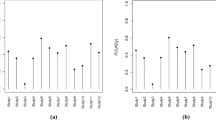Abstract
A new, simple approach to surveillance of serious adverse events during Phase III is suggested. The large-scale Phase III studies are typically double-blind comparisons of the drug with placebo, or a control, performed in order to assess the risk of frequent adverse events. The risk of rare and severe adverse events cannot be assessed with sufficient precision, but the events must be monitored in order to stop the trials if there is a major safety problem. This paper suggests a cumulative sum (CUSUM) approach, where the events in the treatment group are cumulated, adjusting for the expected numbers based upon the total number of serious adverse events. Thus, if there are many events in the treatment group compared to the control group, there will be an alarm. The procedure requires unblinding the treatment for serious adverse events, but no other information from the ongoing studies. Exact probability properties of this sequential Bernoulli procedure can be evaluated by means of Markov chain methods. Optimizing the surveillance program with respect to the mean time to alarm (the standard in CUSUM applications) leads to a design that depends upon the alternative considered, whereas the optimum solution based on the probability of alarm within the expected course of the study is independent of the alternative. The procedure was applied to adverse events for NNC 46-0020, a partial estrogen receptor agonist. The finding of too many adverse events led to closure of the study.
Similar content being viewed by others
References
Chen R. A surveillance system for congenital malformations. JAMA. 1978;73:323–327.
Gallus G, Mandelli C, Marchi M, Radaelli G. On surveillance methods for congenital malformations. Stat Med. 1986;5:565–571.
Lie RT, Heuch I, Irgens LM. A new sequential procedure for surveillance of Down’s syndrome. Stat Med. 1993;12:13–25.
Lucas JM. Counted data CUSUM’s. Technometrics. 1985;27:129–144.
Brook D, Evans DA. An approach to the probability distribution of CUSUM run length. Biometrika. 1972; 59:539–549.
Wald A. Sequential Analysis. New York: John Wiley and Sons; 1947.
Author information
Authors and Affiliations
Corresponding author
Rights and permissions
About this article
Cite this article
Hougaard, P. A Surveillance Program for Serious Adverse Events During Phase III Drug Development Studies. Ther Innov Regul Sci 35, 1301–1314 (2001). https://doi.org/10.1177/009286150103500426
Published:
Issue Date:
DOI: https://doi.org/10.1177/009286150103500426




